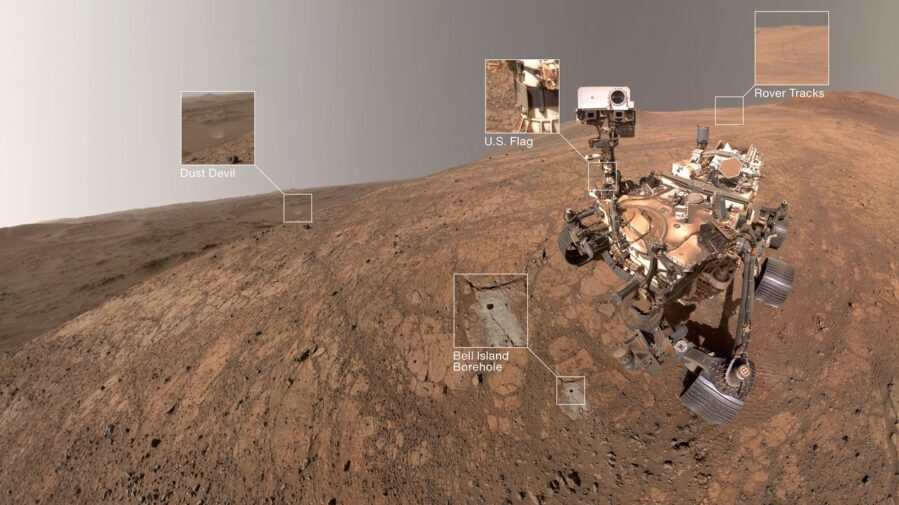A whirling dust devil crashed NASA’s Perseverance rover photo session on Mars, creating an unexpected highlight in the robot’s latest selfie.
The six-wheeled explorer captured the atmospheric phenomenon swirling in the background while commemorating its 1,500th Martian day exploring the Red Planet’s ancient terrain. The timing couldn’t have been more perfect—as Perseverance posed near a fresh borehole on “Witch Hazel Hill,” the distant dust devil added a dynamic element to what would become the rover’s most striking self-portrait yet.
The May 10 selfie marks a significant milestone for the nuclear-powered rover, which has been methodically exploring Jezero Crater’s rim for the past five months. Located in an area scientists nicknamed Witch Hazel Hill, the site represents some of the most geologically interesting terrain Perseverance has encountered since landing in February 2021.
Capturing the Perfect Martian Moment
“The rover self-portrait at the Witch Hazel Hill area gives us a great view of the terrain and the rover hardware,” said Justin Maki, Perseverance imaging lead at NASA’s Jet Propulsion Laboratory in Southern California. “The well-illuminated scene and relatively clear atmosphere allowed us to capture a dust devil located 3 miles to the north in Neretva Vallis.”
The photogenic dust devil wasn’t the only star of this Martian photo shoot. Bright sunlight illuminated Perseverance’s deck while casting dramatic shadows beneath the chassis. Directly in front of the rover sits the “Bell Island” borehole—evidence of the mission’s ongoing sample collection efforts.
Creating this masterpiece required serious robotic choreography. The selfie combines 59 individual images taken by the WATSON camera mounted on Perseverance’s robotic arm, with each shot requiring precise positioning.
Engineering Marvel in Action
“To get that selfie look, each WATSON image has to have its own unique field of view,” explained Megan Wu, a Perseverance imaging scientist from Malin Space Science Systems in San Diego. “That means we had to make 62 precision movements of the robotic arm. The whole process takes about an hour, but it’s worth it. Having the dust devil in the background makes it a classic. This is a great shot.”
The image serves more than just public relations purposes. Engineering teams use these detailed portraits to assess the rover’s condition after months of Martian exploration. Dust accumulation, instrument status, and overall hardware health become clearly visible in these comprehensive self-examinations.
Key achievements by Perseverance’s 1,500th sol include:
- 37 rocks and boulders analyzed with science instruments
- 26 rock cores collected (25 sealed, 1 left unsealed)
- Over 22 miles traveled across Martian terrain
- Continuous power generation from radioisotope thermoelectric generator
Ancient Rocks, New Discoveries
While dust devils provided the visual drama, Perseverance’s current mission focuses on exploring “Krokodillen”—a 73-acre plateau that may contain some of Mars’ oldest rocks. Named after a Norwegian mountain ridge, this area represents a crucial boundary between Jezero Crater’s ancient rim and the surrounding plains.
“The last five months have been a geologic whirlwind,” said Ken Farley, deputy project scientist for Perseverance from Caltech in Pasadena. “As successful as our exploration of Witch Hazel Hill has been, our investigation of Krokodillen promises to be just as compelling.”
The Krokodillen region holds particular scientific interest because it contains clay minerals—geological evidence that liquid water once flowed across this now-barren landscape. These clays formed during Mars’ Noachian period, the planet’s earliest geological era, making them potentially billions of years old.
Strategic Sample Storage
Perseverance has adopted a new sampling strategy that allows maximum flexibility for future discoveries. Rather than immediately sealing every rock core, the mission now keeps select samples unsealed in case more compelling specimens are found down the road.
“We have been exploring Mars for over four years, and every single filled sample tube we have on board has its own unique and compelling story to tell,” said Perseverance acting project scientist Katie Stack Morgan. “There are seven empty sample tubes remaining and a lot of open road in front of us, so we’re going to keep a few tubes—including the one containing the Bell Island core—unsealed for now.”
The dust-covered rover continues its methodical exploration despite accumulating Martian grit over 1,541 Earth days of operation. As project manager Art Thompson noted: “After 1,500 sols, we may be a bit dusty, but our beauty is more than skin deep.”
With years of potential discoveries still ahead, this dust devil photobomb serves as a reminder that Mars remains full of surprises—even in the middle of a routine selfie session.
If our reporting has informed or inspired you, please consider making a donation. Every contribution, no matter the size, empowers us to continue delivering accurate, engaging, and trustworthy science and medical news. Independent journalism requires time, effort, and resources—your support ensures we can keep uncovering the stories that matter most to you.
Join us in making knowledge accessible and impactful. Thank you for standing with us!

